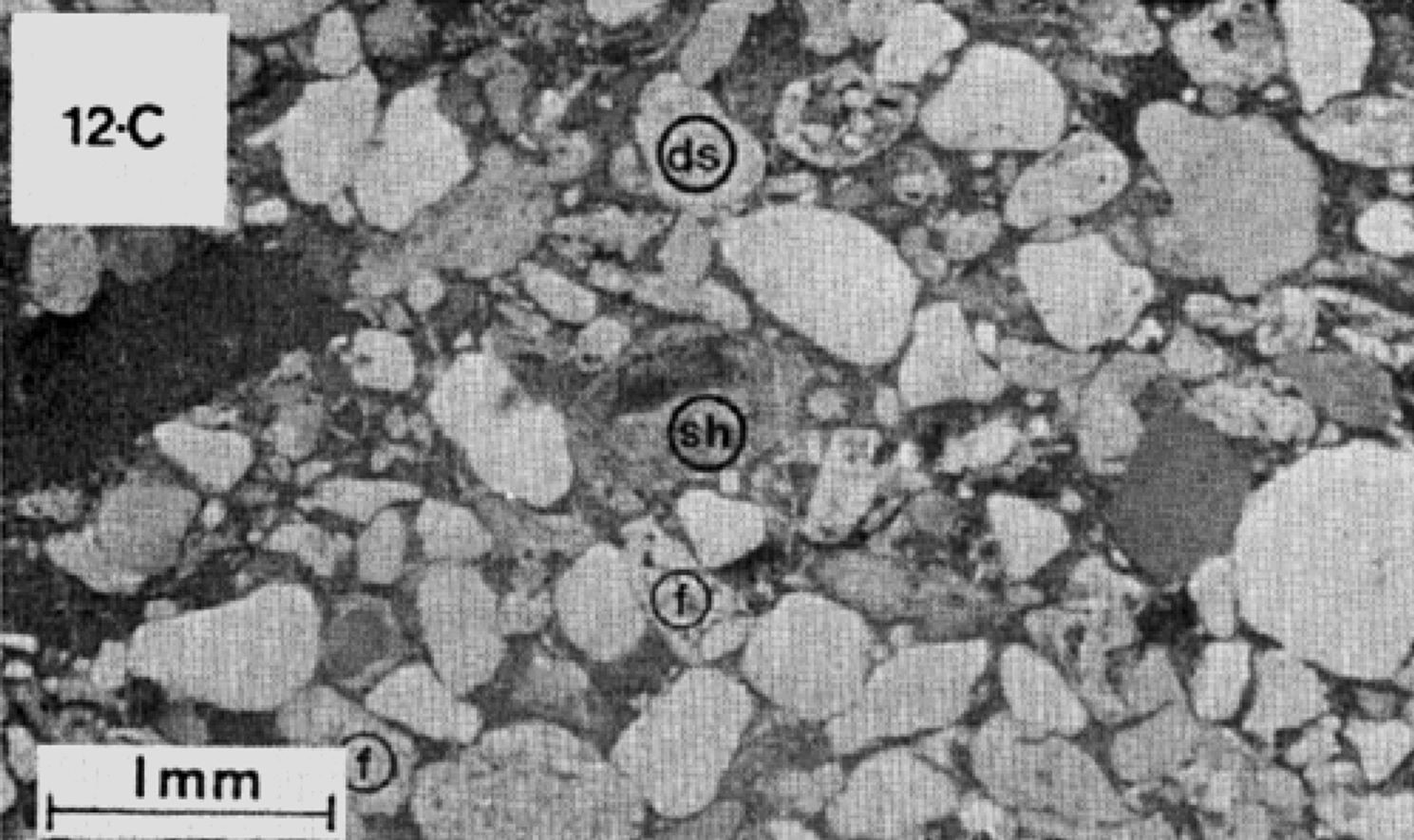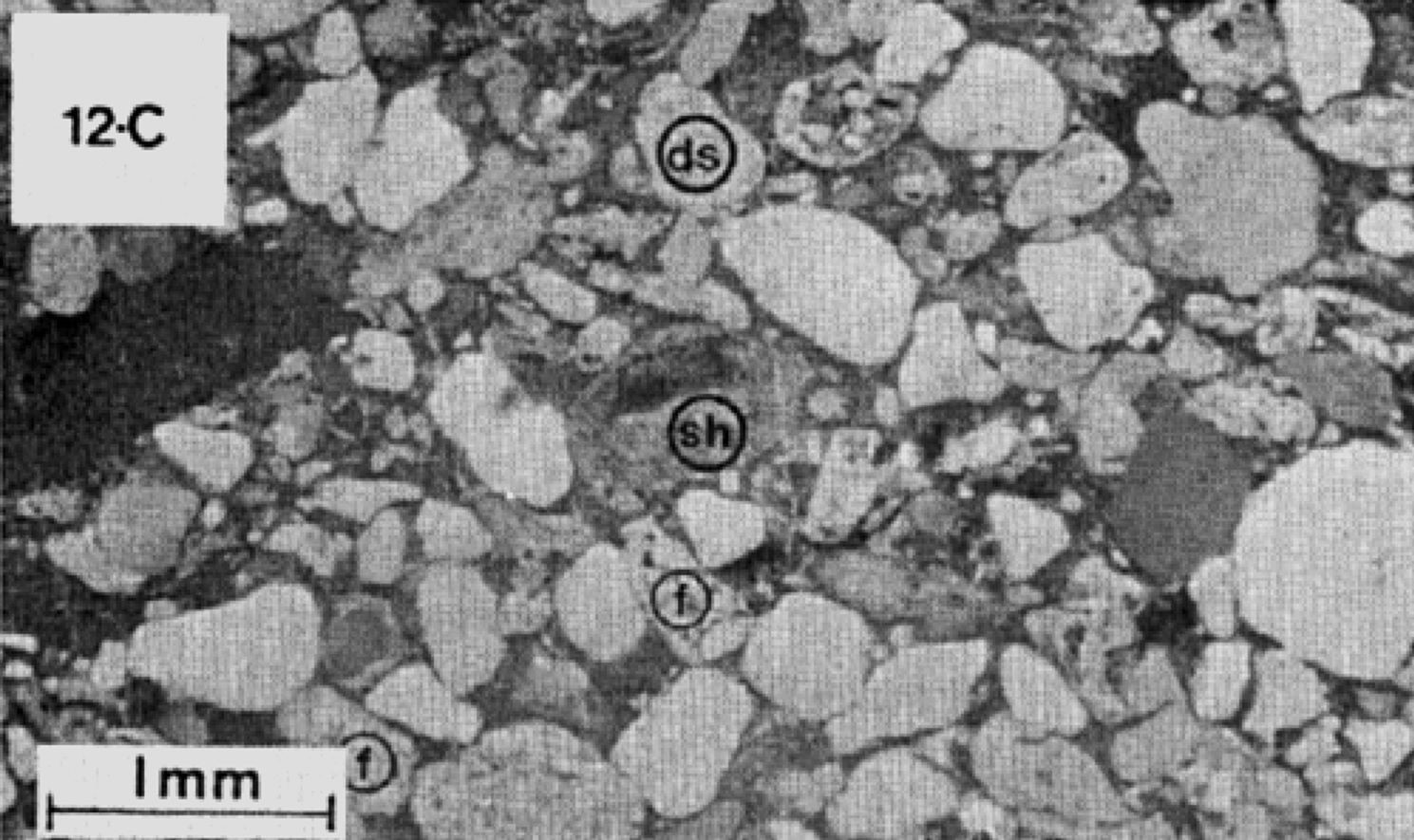
DISCLAIMER: This English version is translated from the original French. In case of any discrepancy, the French version shall prevail.
| Author(s): | Dimroth, 1965, 1968 |
| Age: | Paleoproterozoic |
| Stratotype: | The type locality is on the western shore of Otelnuk Lake (NTS sheet 24C01), where the formation outcrops fairly well. |
| Type area: | Otelnuk lake area (NTS sheet 24C01) |
| Geological province: | Churchill Province |
| Geological subdivision: | New Quebec Orogen (Labrador Trough) |
| Lithology: | Mudrock, siltstone, greywacke |
| Category: | Lithostratigraphic |
| Rank: | Formation |
| Status: | Formal |
| Use: | Active |
Background
A flysch-like mudrock and greywacke sequence was originally described by Dimroth (1965) to the NW of Otelnuk Lake. The name Otelnuc Formation was introduced by Dimroth (1968) to designate this sequence. The rocks belonging to the Otelnuc Formation were mainly mapped by Dimroth (1965, 1972, 1978).
Description
The Otelnuc Formation represents a package of allochthonous sedimentary rocks, which consists of a sequence of flysch-like interbedded mudrock, siltstone and greywacke layers (Dimroth, 1965, 1969, 1978). The unit is divided into four informal units of gradual transition. Dimroth (1965) mentions that the contacts between these subdivisions do not outcrop and that narrow folding does not allow their succession or thickness to be determined. The rocks of the Otelnuc Formation were interpreted as turbidites by Dimroth (1978).
The mudrock is dark grey, rarely black in fresh surface and alters to light grey. The rock is well stratified, silty and has tabular laminations (Dimroth, 1965, 1978). The laminations have commonly undergone synsedimentary deformation. The mudrock has two cleavage planes as well as fissility parallel to stratification. It contains low amounts of graphite (Dimroth, 1978).
The grey greywacke (denoted « quartzitic wacke » by Dimroth, 1978) forms thick beds (generally >30 cm) containing numerous fragments of slate, mudrock and chert up to 2 cm long (Dimroth, 1965, 1978). The presence of these fragments gives a spotted salt-and-pepper appearance to the rock. The greywacke is usually homogeneous and massive. Many beds lack laminations or any other internal structure. The rock and mineral fragments are not oriented parallel to the stratification plane. Fragments make up 60 to 70% of the rock and consist of quartz, plagioclase, several types of graphitic mudrock, siltstone, dolomitic siltstone and chert. The matrix is composed of fine green chlorite and sericite. Rhombohedral crystals of authigenic dolomite are present in the matrix, in mudrock fragments and, more rarely, in chert fragments. Authigenic plagioclase rods and muscovite flakes are common, while authigenic magnetite is rare (Dimroth, 1978).
Fine-grained greywacke (more common than coarse-grained greywacke) and siltstone are olive-green, brownish green or brownish grey, finely bedded and do not contain rock fragments visible to the naked eye. These rocks are characterized by well-developed crossbedding, oscillation ripples, subsidence marks, load marks and synsedimentary folds (Dimroth, 1965, 1978). Fissility is well developed parallel to the stratification plane. Flow and penecontemporaneous deformation phenomena, as well as irregular marks of uncertain origin and convolute laminations are also reported by Dimroth (1965, 1978).
Dimroth (1978) points out the presence of relatively pure, loosely structured sandstone at the base of the Otelnuc Formation. The rock is composed of rounded quartz grains (1 mm in diameter) in a matrix of fine quartz fragments. The matrix contains very little clay.
Otelnuc Formation 1 (pPon1): Laminated Grey Mudrock; Lower Amount of Greywacke
Unit pPon1 consists mainly of laminated grey mudrock interbedded with some greywacke (Dimroth, 1965, 1978).
Otelnuc Formation 2 (pPon2): Greywacke (« Quartzitic Wacke »); Lower Amount of Laminated Grey Mudrock
Unit pPon2 consists of greywacke (« quartzitic wacke »), interbedded with some laminated grey mudrock (Dimroth, 1965, 1978).
Otelnuc Formation 3 (pPon3): Laminated Grey Mudrock and Greywacke (« Quartzitic Wacke »); Equally Interbedded
Unit pPon3 consists of interbedded laminated grey mudrock and greywacke (« quartzitic wacke ») in equal proportions (Dimroth, 1965, 1978).
Otelnuc Formation 4 (pPon4): Laminated Grey Mudrock, Well-Stratified Siltstone and Fine-Grained Greywacke
Unit pPon4 consists of laminated grey mudrock and well-stratified fine-grained siltstone and greywacke (Dimroth, 1965, 1978).
Thickness and distribution
The Otelnuc Formation belongs to the allochthonous Schefferville Lithotectonic Zone, as defined by Clark and Wares (2004). It only outcrops in the Otelnuk Lake area, with representative outcrops on the western shore and NW end of the lake (Dimroth, 1965, 1969, 1978). Rocks of the formation are also present south of Otelnuk Lake. The formation is >900 m thick (Dimroth, 1978).
Dating
None.
Stratigraphic Relationship(s)
The rocks of the Otelnuc Formation were deposited between 2169 ±4 and 2142 +4/-2 Ma, i.e. during the depositional period of first-cycle sedimentary rocks (T. Krogh and B. Dressler, unpublished data cited in Clark, 1984, page 4; Rohon et al., 1993; Clark and Wares, 2004). The Otelnuc Formation directly overlies the Savigny Formation west of Otelnuk Lake and downstream of the High Falls (Dimroth, 1969, 1978). According to Dimroth (1969), the contacts between the two formations are gradual. The Otelnuc Formation is thought to be in part the coarser-grained equivalent of the Savigny Formation (Dimroth, 1978).
Paleontology
Does not apply.
References
Publications Available Through SIGÉOM Examine
CLARK, T. 1984. GEOLOGIE DE LA REGION DU LAC CAMBRIEN – TERRITOIRE DU NOUVEAU-QUEBEC. MRN. ET 83-02, 77 pages and 1 plan.
CLARK, T., WARES, R. 2004. SYNTHESE LITHOTECTONIQUE ET METALLOGENIQUE DE L’OROGENE DU NOUVEAU-QUEBEC (FOSSE DU LABRADOR). MRNFP. MM 2004-01, 182 pages and 1 plan.
DIMROTH, E. 1965. GEOLOGIE DE LA REGION DU LAC OTELNUK, TERRITOIRE DU NOUVEAU-QUEBEC. MRN. RP 532, 30 pages and 1 plan.
DIMROTH, E. 1965. PRELIMINARY REPORT, GEOLOGY OF OTELNUK LAKE AREA, NEW QUEBEC TERRITORY. MRN. RP 532(A), 27 pages and 1 plan.
DIMROTH, E. 1969. GEOLOGIE DE LA REGION DU LAC CASTIGNON, TERRITOIRE DU NOUVEAU-QUEBEC. MRN. RP 571, 62 pages and 7 plans.
DIMROTH, E. 1969. PRELIMINARY REPORT, GEOLOGY OF THE CASTIGNON LAKE AREA, NEW QUEBEC TERRITORY. MRN. RP 571(A), 58 pages and 7 plans.
DIMROTH, E. 1972. STRATIGRAPHY OF PART OF THE CENTRAL LABRADOR TROUGH. MRN. DP 154, 304 pages and 6 plans.
DIMROTH, E. 1978. REGION DE LA FOSSE DU LABRADOR ENTRE LES LATITUDES 54° 30′ ET 56° 30′. MRN. RG 193, 417 pages and 16 plans.
Other Publications
DIMROTH, E., 1968. The evolution of the central segment of the Labrador geosyncline; part I: stratigraphy, facies and paleogeography; Neues Jahrbuch für Geologie und Paläontologie, Abhandlungen, Stuttgart; volume 132, pages 22-54.
ROHON, M.L., VIALETTE, Y., CLARK, T., ROGER, G., OHNENSTETTER, D., VIDAL, P.H., 1993. Aphebian mafic-ultramafic magmatism in the Labrador Trough (New Quebec): its age and the nature of its mantle source. Canadian Journal of Earth Sciences; volume 30, pages 1582-1593. https://doi.org/10.1139/e93-136
Suggested Citation
Ministère de l’Énergie et des Ressources naturelles (MERN). Otelnuc Formation. Quebec Stratigraphic Lexicon. https://gq.mines.gouv.qc.ca/lexique-stratigraphique/province-de-churchill/formation-otelnuc_en [accessed on Day Month Year].
Contributors
|
First publication |
Charles St-Hilaire, GIT, M.Sc. charles.st-hilaire@mern.gouv.qc.ca (redaction) Mehdi A. Guemache, P. Geo., Ph.D. (redaction and coordination); Thomas Clark, P. Geo., Ph.D. (critical review); Simon Auclair, P. Geo., M.Sc. (editing); Céline Dupuis, P. Geo., Ph.D. (English version); Nathalie Bouchard (HTML editing). |



